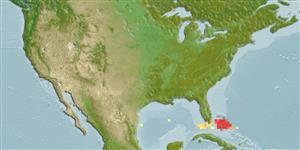>
Ophidiiformes (Cusk eels) >
Bythitidae (Livebearing brotulas)
Etymology: Lucifuga: Latin, lux = light + latin, fugere = to escape, to avoid, to run away from (Ref. 45335).
More on authors: Cohen & Robins.
Environment: milieu / climate zone / depth range / distribution range
Écologie
marin; saumâtre démersal; profondeur 1 - 21 m (Ref. 34024). Subtropical; 26°N - 24°N
Western Central Atlantic: Bahamas.
Taille / Poids / Âge
Maturity: Lm ? range ? - ? cm
Max length : 10.9 cm SL mâle / non sexé; (Ref. 13498)
Rayons mous dorsaux (Total): 86-109; Rayons mous anaux: 66 - 82; Vertèbres: 51 - 55. This species is distinguished from its congeners by the following combination of characters: Vertebrae 13-14+38-42=51-55, dorsal fin rays 86-109, anal fin rays 66-82, pectoral fin rays 17-20, caudal fin rays 10; head profile above eye is strongly depressed, small, developed eyes 0.7-1.8 % SL; palatine teeth present, in 1-7 short irregular rows, with 3-56 teeth total; long gill-rakers 3, dark pigmented (Ref. 57878).
Inhabits dark inland caves, brackishwater sinkholes, and marine blue holes (Ref. 27158. 57878).
Life cycle and mating behavior
Maturité | Reproduction | Frai | Œufs | Fécondité | Larves
Møller, P.R., W. Schwarzhans, T.M. Iliffe and J.G. Nielsen, 2006. Revision of the Bahamian cave-fishes of the genus Lucifuga (Ophidiiformes, Bythitidae), with description of a new species from islands on the Little Bahama Bank. Zootaxa 1223:23-46. (Ref. 57878)
Statut dans la liste rouge de l'IUCN (Ref. 130435)
Menace pour l'homme
Harmless
Utilisations par l'homme
Pêcheries: sans intérêt
Plus d'informations
Noms communsSynonymesMétabolismePrédateursÉcotoxicologieReproductionMaturitéFraiRassemblement de ponteFéconditéŒufsDéveloppement de l'œuf
RéférencesAquacultureProfil d'aquacultureSouchesGénétiqueElectrophoresesHéritabilitéPathologiesTraitementNutrientsMass conversion
CollaborateursImagesStamps, Coins Misc.SonsCiguateraVitesseType de nageSurface branchialeOtolithesCerveauxVision
Outils
Articles particuliers
Télécharger en XML
Sources Internet
Estimates based on models
Preferred temperature (Ref.
123201): 26.1 - 26.9, mean 26.7 °C (based on 39 cells).
Phylogenetic diversity index (Ref.
82804): PD
50 = 0.5078 [Uniqueness, from 0.5 = low to 2.0 = high].
Bayesian length-weight: a=0.00457 (0.00179 - 0.01169), b=3.10 (2.87 - 3.33), in cm total length, based on LWR estimates for this (Sub)family-body shape (Ref.
93245).
Niveau trophique (Ref.
69278): 3.3 ±0.5 se; based on size and trophs of closest relatives
Résilience (Ref.
120179): Très faible, temps minimum de doublement de population supérieur à 14 ans (Assuming Fec < 10).
Fishing Vulnerability (Ref.
59153): Low vulnerability (10 of 100).
